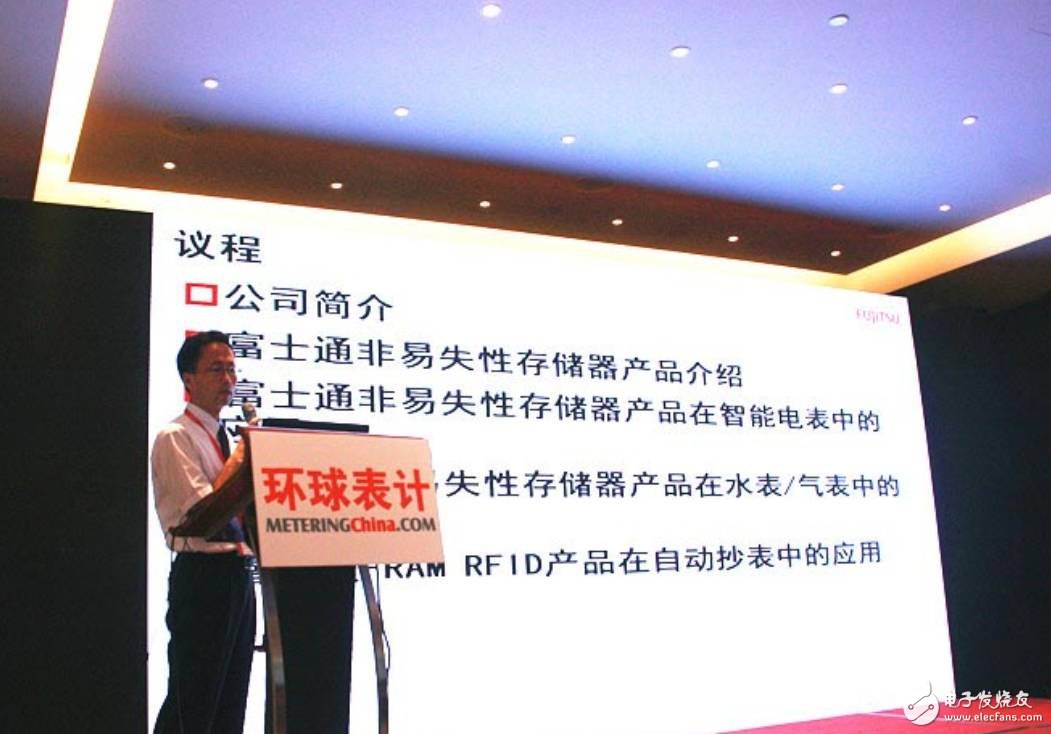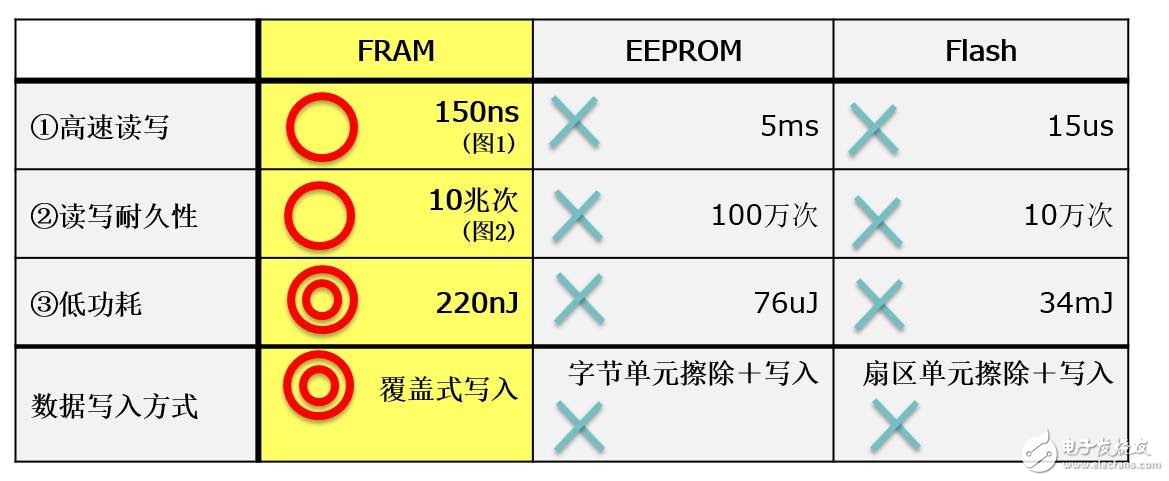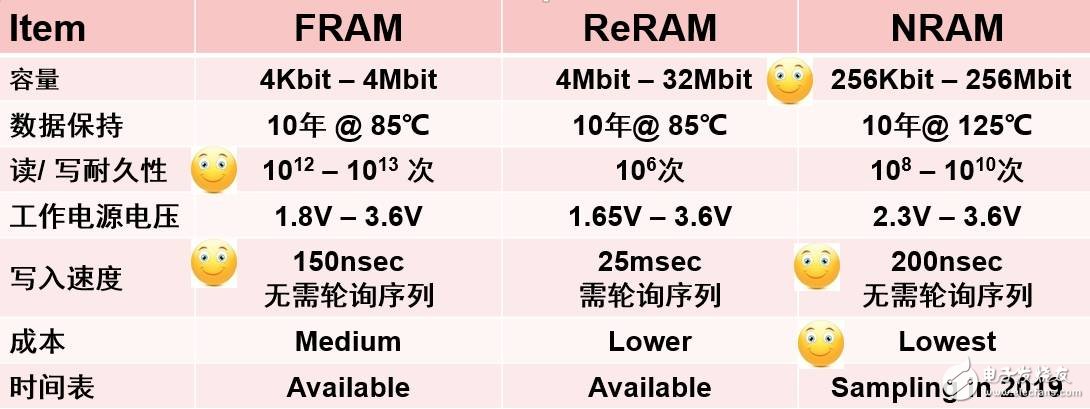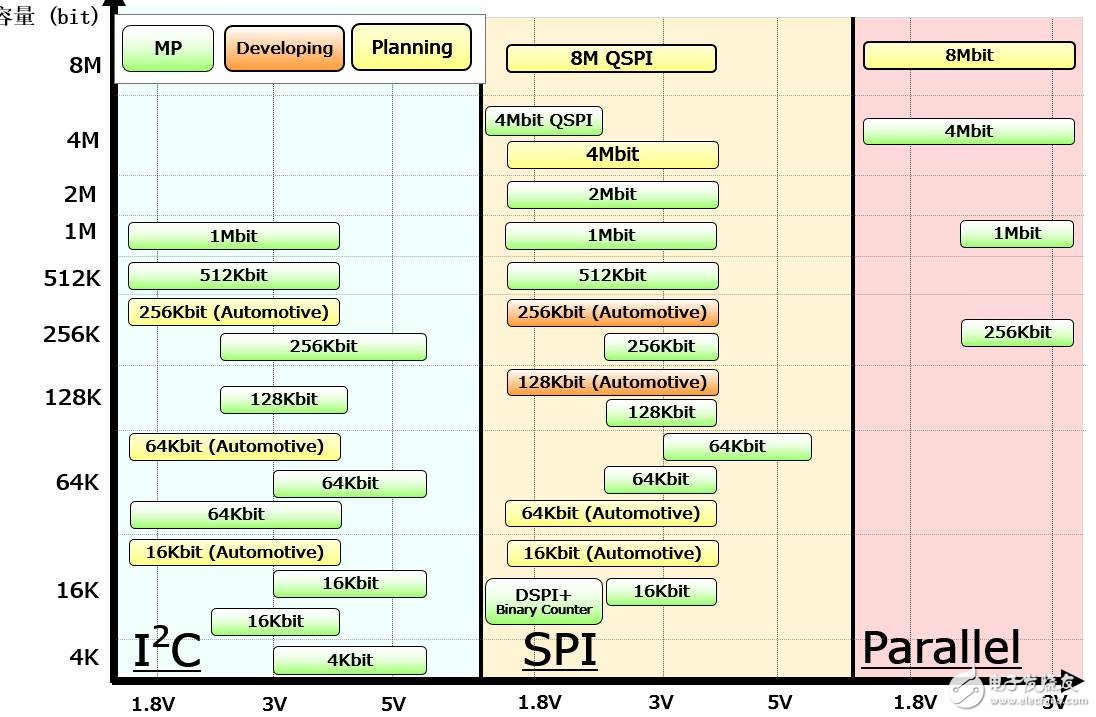 Â
 A recent article in The Wall Street Journal pointed out that the evolution of devices such as smartphones, PCs, and tablets has not been as rapid in recent years, but they are advancing innovation in new ways, and hardware vendors are more customized for specific tasks. chip.
That's right, the diversity of technologies is bringing more optimized design options like "customization" for a variety of applications. The same is true for embedded systems data storage, where various storage technologies with different unique capabilities are providing "customized" solutions for many application needs, of which Fujitsu is doing this on FRAM, NRAM and ReRAM technologies.

As a key part of the system, storage performance is critical
Feng Yixin, director of product management at Fujitsu Electronic Components (Shanghai) Co., Ltd., pointed out in a recent public speech, "Various systems for memory read and write speeds, repeatable read and write times, read and write power consumption, security, and power supply. The requirements are all different, and storage technology is moving toward subdivision." The company's FRAM memory with almost unlimited read and write times, ultra-low power consumption and ultra-high read/write speed has been widely used in various markets in recent years. Examples include medical electronics, metrology, industrial automation, automotive electronics, and the like, which are already very common. "By 2019, Fujitsu will offer a package of storage solutions with unique advantages for embedded system applications including FRAM, NRAM and ReRAM."

Feng Yixin: Key Data Best Storage Solution
A full range of process technology "customized" storage personalized solutions
As an "atypical" of storage technology, FRAM technology itself has a strong atypical characteristic - it is a memory that uses ferroelectric and ferroelectric effects of ferroelectric materials (PZT, etc.) for non-volatile data storage. It can achieve random reading like SRAM, and has the characteristics of real-time saving of important data after power-down like Flash and EEPROM. In addition, Fujitsu Semiconductor FRAM has high-speed write performance, guarantees 10 trillion read and write times, and is most suitable for measurement instrument applications that need to record data in real time.

Comparison of main performance of FRAM and other memories
"Even if there is a power outage or dip in the power system, the data in the write operation can be completely protected. Our FRAM is widely recognized and used in related measuring instruments such as electric meters, as well as in industrial automation equipment and financial terminals that require high reliability.
——Feng Yixin
In fact, this personalized "customized" product solution has been extended to more applications, Fujitsu recently launched a new FRAM solution - MB85RS128TY and MB85RS256T for the first time to expand the working environment temperature up to 125 degrees Celsius, designed for cars The industry and industrial control machinery with motors are designed to meet the stringent automotive industry AEC Q100 standard specifications.
Fujitsu last year's industry's highest density ReRAM (variable resistive memory) product MB85AS4MT, with the industry's lowest non-volatile memory read power consumption (average consumption of only 0.2mA at 5MHz frequency). ReRAM combines the read and write speed of DRAM with the non-volatile nature of SSD. In other words, the memory can still remember the data after the power is turned off. "If ReRAM has enough space, a PC with ReRAM will not need to load time." Feng Yixin's example makes people impressed with the fast write characteristics of ReRAM. "ReRAM has always been considered as an alternative to future flash memory. Store 1T data on a single chip with an access rate 20 times faster than flash."
Fujitsu Semiconductor became the world's first manufacturer to announce the production of NRAM. NRAM performance is 1000 times that of DRAM, but new memory like NAND flash memory stores data. Fujitsu Semiconductor plans to develop a custom embedded memory-grade memory module with DDR4 interface by the end of 2018. NRAM products will target data centers and servers, and may also be used in consumer products or even mobile devices. Because NRAM consumes very little power and does not require background data erasure operations, it can extend the standby time of mobile devices to months.

Fujitsu non-volatile memory products: FRAM, ReRAM, NRAM
High read/write endurance and high-speed FRAM have become the best solution for storing important data in industrial applications such as power meters. Low-power and large-capacity ReRAM are mainly read-oriented, battery replacement is difficult, and meter reading is difficult. The best solution for a flow meter that is difficult but requires a long time to maintain data; high read/write endurance and high capacity NRAM will also be another important component to improve meter performance.
Feng Yixin concluded in a recent speech in the meter industry. As a product that has been mass-produced for more than 18 years, FRAM is still the current star of Fujitsu's storage solutions, and ReRAM and NRAM will complement the embedded system storage package.
The popularization of three-phase electric meters has created the "model project" of FRAM.
"Fujitsu's global FRAM memory sales have exceeded 3.3 billion in 2016, including 40 million units for world electric meter customers. The world's major meter manufacturers, including China, are loyal fans of FRAM products, especially three-phase. The application penetration rate of FRAM in electric meters is very high." Feng Yixin pointed out. According to him, the significant competitive advantage embodied in the global three-phase electricity meter has become a persuasive “model project†for FRAM's global promotion.
Fujitsu FRAM plays a key role in applications that need to accurately record and store critical data from smart meters.
The important data for power usage needs to be stored at very short intervals (1 to 3 times/second). When the power is turned off, these important data must be accurately and completely preserved. The moment before the power failure, these are the unique advantages of FRAM. To help users write and save current important data in real time.
Feng Yixin said, "Fujitsu FRAM can accurately store power usage data in real time, thus ensuring accurate charging of the power industry. The smart meter with FUJITSU FRAM is the ideal solution for power companies."

Fujitsu offers a wide range of FRAM products in the industry
FRAM has a significant advantage in storage performance, but as a metering product customer, the primary concern is quality.
"Fujitsu Semiconductor has used mature technology to produce FRAM for more than 18 years, with a cumulative sales of 3.3 billion. The high reliability, complete supply system and ambitious business vision are the key to our FRAM's widespread use in electricity meters. One of the factors.
——Feng Yixin
It is reported that Fujitsu's powerful FRAM product lineup - serial interface memory products have 16Kb to 4Mb SPI interface products, and 4Kb to 1Mb I2C interface products. The power supply voltage is expanded to 1.8V working products in addition to the main 3.3V working products.
Ultra low power & high security, FRAM breaks through in the traditional three-table market
The three-phase electricity meter market, which emphasizes data security and reliability, is undoubtedly the star application of FRAM, and how does the traditional civilian market FRAM of single-phase electricity meters, gas meters and water meters break through? Feng Yixin believes that the ultra-low power consumption and high security make FRAM's success in the three-phase meter market continue to replicate. "By obtaining the electricity consumption data of your home, you can judge the activity of your family, which may facilitate the bad guys to carry out illegal activities." For security issues, Feng Yixin's perspective seems to be a bit of a 007 movie, but in fact such security considerations It is no exaggeration that single-phase meters are opening FRAM in the second important market for power applications outside of three-phase meters based on various safety and performance considerations.
The unique advantage of FRAM is the use of different cell structures that have excellent device-level tamper resistance, prevent unauthorized data reading, and pass a series of stringent safety certification standards, for example in the French Ministry of Defense. In the ESAP (based on the international standard ISO/IEC 15408 evaluation assurance level) certification implemented by DCSSI, FRAM has passed EAL4+ certification. FRAM-based power storage scheme When a hacker's tampering event occurs, low-power and high-speed FRAM can instantaneously erase important data by using a small battery power supply (standard discharge current: 0.1 mA) that supplies power to the RTC.
It is reported that Fujitsu FRAM for single-phase smart meters proposes that Fujitsu plans to develop ultra-low-capacity FRAM (1Kb) and EEPROM, which can make single-phase meters achieve high reliability of meter performance and remove capacitors to reduce BOM cost.
"With the introduction of ultra-low-capacity FRAM solutions and the new industry specifications for smart meters that may gradually improve reliability and safety standards, the advantages of FRAM will be demonstrated in single-phase meters.
——Feng Yixin
In traditional data storage, with the popularity of smart meters, Fujitsu FRAM RFID dual interface will become the best solution for meter reading system to improve work efficiency, help power companies save costs, and realize power-off protection data security and reliability, and achieve Wireless meter reading passive fault detection.
For the gas meter in the traditional three-meter, which is more cost-sensitive, where is the opportunity for FRAM? Power consumption is key to gas and water meter solutions because gas and water meters must be powered by batteries. Taking 64Kb data write as an example, the MB85RC64T uses an I2C interface and can operate at a maximum frequency of 3.4 MHz and a wide supply voltage of 1.8V to 3.6V. In addition, the average current is extremely low, 170μA at 3.4 MHz (80μA at 1 MHz), so using FRAM means not only miniaturizing the battery, but also extending battery life.
The Chinese market has become an important market for Fujitsu Semiconductor FRAM in the world. We have given Chinese customers great support in terms of product price, delivery, factory capacity allocation and technical support.
Feng Yixin often mentioned this in multi-faceted communication with government, water meters, gas meter design manufacturers, and water and gas companies. FRAM's superior characteristics After being deeply concerned by the industrial three-phase electricity meter market, FRAM is ushering in a new wave of application growth in the single-phase meter, water meter and gas meter industry.
A Small Computer System Interface (SCSI) connector, also pounced as [scuzzy" connector, is used for physically connecting and transferring data between computers and peripheral devices.
SCSI is the small computer system interface, which is an independent processor standard used for the system level interface between computer and intelligent devices (hard disk, floppy, optical drive, printer, scanner, etc.). It is an intelligent universal interface standard, which has the function of communicating with various types of peripherals. SCSI uses the standard software interface of ASPI (SCSI programming interface) to make the driver communicate with the SCSI adapter installed inside the computer. SCSI interface is widely used in high-speed data transmission technology on minicomputers. SCSI interface has many advantages, such as wide application range, multitask, wide bandwidth, low CPU utilization, and hot plug.
SCSI connectors type and interfaces
Centronics 50-pin connector: The Centronics 50-pin connector was once the most widely used SCSI connector. An external connector only, the Centronics is a SCSI-1 connector that looks the same as the Centronics cable that attaches to a parallel port printer. The Centronics 50-pin cable comes in male and female styles, and gender changers and cable converters are commonly available. Although used on older SCSI devices and external drive enclosures, this interface is no longer heavily used, due to its slow speed and short cable lengths.
High-density 50-pin connector: The high-density 50-pin connector is used on scanners and Jaz drives. It is one of the more common SCSI connectors and is usually used to connect SCSI-2 devices. Both ends of the cable are usually 50-pin male, while the sockets on the host adapter and external devices are 50-pin female.
DB 25-pin connector: The DB 25-pin or D Sub 25 is by far the most widely used connector. This connector is used for parallel and serial printers in addition to the many other devices available. Both ends of the cable are usually 25-pin male, while the sockets on the host adapter and external devices are 25-pin female. This cable is almost always an external connector.
Note: DB-25 SCSI CABLES are not compatible with and should not be used as serial or printer cables; serial cables and printer cables should not be used or attached to DB-25 SCSI adapters. You can short out the SCSI host adapter or the motherboard by using the wrong cable. Marking cables is the best way to avoid this.
IDC50 connector: The IDC50 is the most common internal SCSI connector. It is very similar to the standard IDE internal ribbon cable. The IDC50 SCSI cable is considerably wider then an IDE ribbon cable; in fact, it is usually the widest standard internal cable in use. This is a standard SCSI-2 10MBps internal SCSI cable. Many low-end cables have only two or three connectors, allowing for one or two devices to be attached to the cable. Seven-device cables are available, though they are often expensive and require a large case, as the cables may be four or five feet long.
High-density 68-pin connector: The high-density 68-pin connector is the SCSI connector of choice for SCSI-3 host adapters and peripherals. There is an internal ribbon cable version that looks very similar to the IDC50 connector. Many low-end cables have only two or three connectors, allowing for one or two devices to be attached to the cable. Seven-device cables are available, though they are often very expensive and require a large case, as the cables may be three or more feet long. Both ends of the external cable are usually 68-pin male, while the sockets on the host adapter and external devices are 68-pin female.
SCA 80-pin Micro-Centronics connector: SCA stands for Single Connector Attachment, a type of disk drive connector that includes connection pins for the power cables as well as the data wires. A SCA connector uses an 80-pin plug and socket to connect peripherals. This connector combines power, data channel, and ID configuration for fast installation and removal. SCA connectors are typically found only on high-end SCSI hard disks. The SCA interface was designed to provide a standard connection for systems using drives that can be hot-swapped. SCA makes swapping SCSI hard drives much easier than with traditional SCSI cables, plugs, and sockets. An adapter enables SCA drives to fit into standard SCSI enclosures.
SCSI SFF 8482: Also called "4x internal" by some vendors. This is a connector with the same form factor as SATA with the addition of a "bump" to key it specifically for SAS. (SATA drives can be plugged into SAS controllers, but SAS drives will not function with a SATA controller; hence, the necessity for the key bump on the connector.) As the name says, it's meant to be used internally, i.e., inside the computer case.
SCSI SFF 8484: Also called "32-pin" or "MultiLane". This is a high density connector usually intended to plug into the motherboard, controller, or backplane itself. Cables with this connector on one end usually have four individual SFF 8482 connectors on the other.
Serial Attached SCSI SFF 8470: Also called "4x external" by some vendors. This is simply a version of the SFF 8484 that's meant to be used with external (i.e., not located within the case) drives.
Scsi Connector,Half Pitch Scsi Connectors,Scsi Lead Half Pitch Male,SCSI (SAS) Connectors,Female Scsi Connector,SCSI Connectors I/O Connectors,Manufacturers and Suppliers in China
ShenZhen Antenk Electronics Co,Ltd , https://www.antenkconn.com